B0041VYHGW EBOK (115 page)
Authors: David Bordwell,Kristin Thompson

By choosing certain sounds, the filmmaker guides our perception of the image and the action. In one scene from Jacques Tati’s
Mr. Hulot’s Holiday,
vacationers at a resort hotel are relaxing
(
7.10
).
Early in the scene, the guests in the foreground are murmuring quietly, but Hulot’s Ping-Pong game is louder; the sound cues us to watch Hulot. Later in the scene, however, the same Ping-Pong game makes no sound at all, and our attention is drawn to the muttering cardplayers in the foreground. The presence and absence of the sound of the Ping-Pong ball guides our expectations. If you start to notice how such selection of sound shapes our perception, you will also notice that filmmakers often use sound quite unrealistically, in order to shift our attention to what is narratively or visually important.
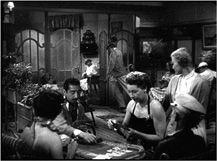
7.10 In
Mr. Hulot’s Holiday,
in the foreground, guests quietly play cards while in the depth of the shot, Mr. Hulot is frantically playing Ping-Pong.
Our scene from
Mr. Hulot’s Holiday
also points up the importance of how a chosen sound may have its acoustic qualities transformed for a particular purpose. Thanks to a manipulation of volume and timbre, the Ping-Pong game gains in vividness. When two sounds are of the same frequency or loudness, contemporary sound designers freely adjust one to make it stand out more clearly. During the jungle chase in
Indiana Jones and the Kingdom of the Crystal Skull,
the skull’s thump was altered. “I changed its pitch so that it would coexist with the music,” sound designer Ben Burtt explained.
At the limit, wholly new sounds may be made of old ones. The noises emitted by the demonically possessed girl in
The Exorcist
blended screams, animal thrashings, and English spoken backward. To create the roar of a
Tyrannosaurus rex
for
Jurassic Park,
sound engineers fused a tiger’s roar, a baby elephant’s trumpeting at midrange frequencies, and an alligator’s growl for the lower tones. On film, even jet planes’ roars typically include cries of animals—not only lions and elephants but monkeys as well.
Nowadays, film sound is normally reprocessed to yield exactly the qualities desired. A
dry recording
of the sound in a fairly nonreflective space will be manipulated electronically to yield the desired effect. For instance, the voice of someone on the telephone is typically treated with filters to make it more tinny and muffled. (In Hollywood parlance, this is called “futzing” the sound.) The almost nonstop rock-and-roll music of
American Graffiti
used two recordings of the music. A dry one was prepared for moments when the music was to dominate the scene and had to be of high quality. A more ambient one for background noise was derived from a tape recorder simply playing the tune in a backyard.
“Is it better to say, ‘I love you,’ bang, then cut to the reaction? Or is it better to say, ‘I love you,’ hang on it a beat to show the emotion of the person delivering the line, then go for the reaction? It’s a matter of choice. Either way, there’s a different result for the audience looking at it. Are their sympathies with the guy who said the line, or the girl who said the line? Or is the audience saying, ‘Don’t believe him, he’s going to screw you over!’ … If you find the frame to cut on at
that
right moment, the audience will be totally satisfied.”— Tom Rolf, editor
Guiding the viewer’s attention, then, depends on selecting and reworking particular sounds. It also depends on
mixing
, or combining them. It is useful to think of the sound track not as a set of discrete sound units but as an ongoing
stream
of auditory information. Each sonic event takes its place in a specific pattern. This pattern both links events in time and layers them at any given moment.
We can easily see how the sound track offers a stream of auditory information by considering a scene cut according to classical continuity principles. When film-makers edit conversations in shot/reverse shot, they often use a
dialogue overlap
to smooth down the visual change of shot. In a dialogue overlap, the filmmaker continues a line of dialogue across a cut. During a conversation in John McTiernan’s
The Hunt for Red October,
we get the following shots and dialogue:
- (ms) Over the political officer’s shoulder, favoring Captain Ramius
(
7.11
)Officer: “Captain Tupalev’s boat.”
Ramius: “You know Tupalev?”
Officer: “I know he descends …”
- (ms) Reverse angle over Ramius’s shoulder, favoring the officer
(
7.12
)Officer (continuing): “… from aristocracy, and that he was your student. It’s rumored he has a special …”
- (mcu) Reverse angle on Ramius
(
7.13
)Officer (continuing): “… place in his heart for you.”
Ramius: “There’s little room in Tupalev’s heart for anyone but Tupalev.”
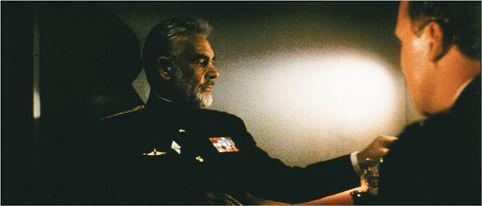
7.11
The Hunt for Red October:
shot 1.
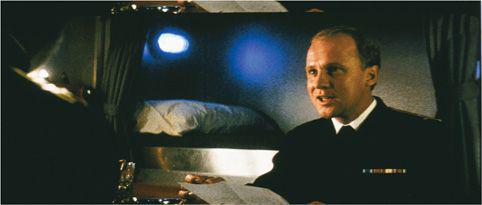
7.12
The Hunt for Red October:
shot 2.
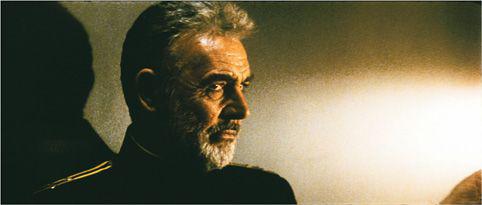
7.13
The Hunt for Red October:
shot 3.
CONNECT TO THE BLOG
We’ve been fortunate enough to sit in on some mixing sessions and learn from people who mix sound. See “Christian Bale picks up a rail”
www.davidbordwell.net/blog/?p=963
, “What does a Water Horse sound like?”
www.davidbordwell.net/blog/?p=1718
, and “The boy in the Black Hole”
www.davidbordwell.net/blog/?p=2212
.
Here the political officer’s chatter provides an auditory continuity that distracts from the shot changes. Moreover, by cutting to a closer view of the listener before a sentence is finished, the sound and editing concentrate our attention on Ramius’s response. As a Hollywood editor puts it, “The minute a telling word or a question is posed … I go for a reaction to see … how they are trying to formulate the answer in their face or dialogue.” The principle of dialogue overlap can be used with noise as well. In the
Hunt for Red October
scene just mentioned, sounds of a spoon clinking in a tea cup and of papers being riffled also carry over certain cuts, providing a continuous stream of sonic information.
This auditory stream can involve more than simply linking one line of dialogue or bit of noise to another. We have already seen that in production, combining sounds is usually done after shooting, in the mixing process. For example, in
Jurassic Park,
Steven Spielberg manipulates volume unrealistically for purposes of narrative clarity. After a live cow has been lowered into the velociraptors’ pen, the South African hunter gives important information about the habits of these predators, and his voice comes through louder than those of characters closer to the camera
(
7.14
).
The mixer can precisely control the volume, duration, and tone quality of each sound. In modern filmmaking, a dozen or more separate tracks may be mixed in layers at any moment. The mix can be quite dense, as when an airport scene combines the babble of several distinct voices, footsteps, luggage trolleys, Muzak, and plane engines. Or the mix can be very sparse, with an occasional sound emerging against a background of total silence. Most cases will fall somewhere between these extremes. In our
Hunt for Red October
scene, a distant throbbing engine and slight brushings of fabric form a muted background to the dialogue exchange.
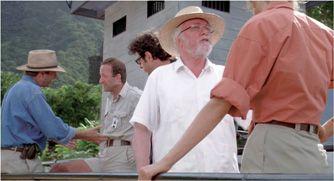
7.14 In
Jurassic Park,
although Hammond and Ellie are closer to the camera than is anything else in the shot, their dialogue is an unintelligible murmur, while the exposition about velociraptors given by the hunter in the background is clearly audible.
“For the last few years—since
Blue Velvet,
I think—I have tried to do most of the music before the shoot. I discuss the story with my composer, Angelo Badalamenti, and record all sorts of music that I listen to as I’m shooting the film, either on headphones during dialogue scenes or on loudspeakers, so that the whole crew gets in the right mood. It’s a great tool. It’s like a compass helping you find the right direction.”— David Lynch, director
The filmmaker may create a mix in which each sound blends smoothly with the others. This is commonly the case when music and effects are mixed with speech. In classical Hollywood cinema of the 1930s, the musical score may become prominent in moments in which there is no dialogue, and then it’s likely to fade unnoticeably down just as the characters begin to talk. (In studio parlance, this is called
sneaking in
and
sneaking out.
) Sometimes the mix will associate sounds evocatively. In
The English Patient,
when the nurse feeds the patient a plum, a distant churchbell rings, suggesting a peaceful refuge from the war.